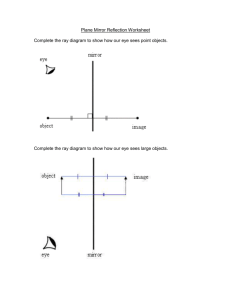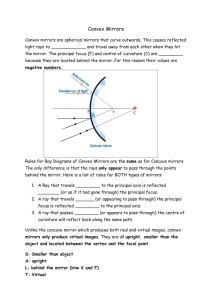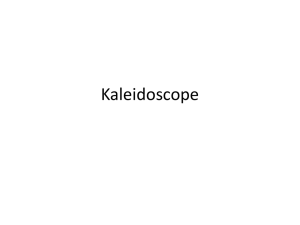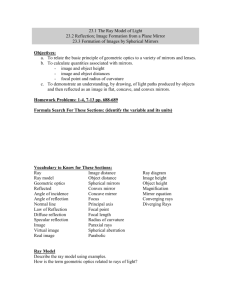r Dr. Mike
advertisement
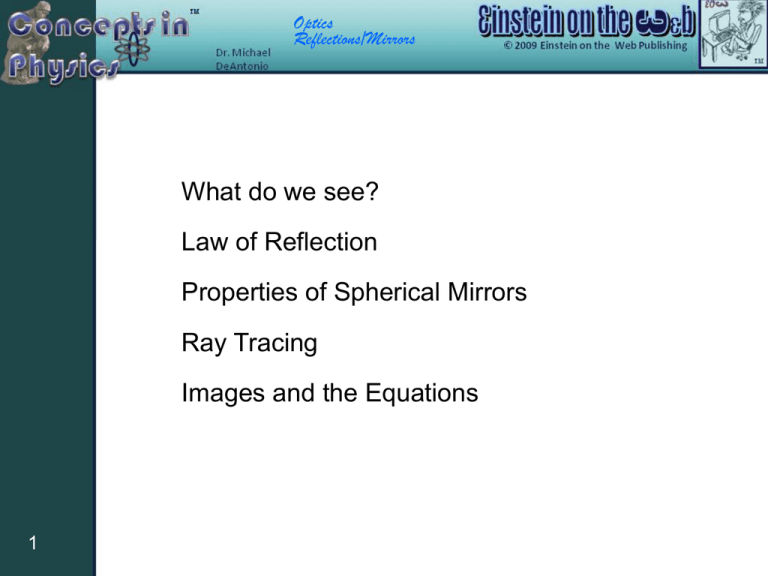
Optics Reflections/Mirrors What do we see? Law of Reflection Properties of Spherical Mirrors Ray Tracing Images and the Equations 1 Optics Reflections/Mirrors 2 Optics Reflections/Mirrors All reflected rays bounce in such a way as to follow the law of reflection. Law of Reflection θr θi r i Where the rays appeared to have crossed is where we see the image. 3 Optics Reflections/Mirrors If only one reflected ray hits my eye, I will see the image. 4 Optics Reflections/Mirrors For some parts of an object the reflected ray never hits the eye. Any part of the object on this side of the red line is not seen by the eye. Any part of the image on this side of the red line is not seen by the eye. 5 Optics Reflections/Mirrors For all reflected light rays, the angle of incidence θi is equal to the angle of reflection θr. The eye sees the point from which the light originated as though it were in a straight line from the angle of the reflected ray. The eye will not see the reflection of any point on the object unless one of the rays originating from that object strikes the mirror and reflects into the eye. The eye will not see any part of an object for which all rays approaching the eye hits the back of the mirror. 6 Optics Reflections/Mirrors The law of reflection states that: The incident ray, the reflected ray and the normal to the mirror all lie in the same plane. The angle of reflection equals the angle of incidence. θi θr 7 Optics Reflections/Mirrors For a spherical mirror, rays that start at the center point will go back through the center point. This is because the normal to any point on the spherical surface of the mirror points to the center of the sphere. C 8 r Optics Reflections/Mirrors The principal axis is any line which crosses through the center point of the mirror and touches the mirror itself. The most commonly used axis is the one that bisects the mirror. C 9 Optics Reflections/Mirrors For any mirror, the focal point is defined as the point where parallel rays that are near to the principal axis reflect to a point. Any rays that originate at the focal point will reflect parallel to the principal axis. C F f 10 Optics Reflections/Mirrors There are two types of spherical mirrors: concave (converging) and convex (diverging). Parallel rays reflecting off a convex mirror do not reflect to a point. Instead they diverge in such a way as to appear to be coming from the focal point. F 11 C Optics Reflections/Mirrors Although any ray may be traced to find out where an image point is, there are three principal rays that make the job easier. 1. Parallel Ray: Comes in parallel to the principal axis and goes out through the focal point. 2. Focal Ray: Comes in through the focal point and goes out parallel to the principal axis. 3. Radial Ray: Comes in through the center point and retraces its path. C 12 F Optics Reflections/Mirrors Although any ray may be traced to find out where an image points is, there are three principal rays that make the job easier. 1. Parallel Ray: Comes in parallel to the principal axis and goes out as though it came from the focal point. 2. Focal Ray: Comes in toward the focal point and goes out parallel to the principal axis. 3. Radial Ray: Comes in toward the center point and retraces its path. F 13 C Optics Reflections/Mirrors Images are real if all of the light rays pass through them. Otherwise they are virtual. Real images are inverted, virtual images are upright. For mirrors, real images are found on the same side of the mirror as the object. Virtual images are not. Images may be smaller or larger than the object. 14 Optics Reflections/Mirrors f, do , ho and di are all positive and hi is negative. C F F C f and di are negative and do, ho and hi are positive. Focal length (f), object distance (do) and image distance (di) switch signs as you move across the mirror. 15 Heights (ho for object and hi for image) are positive if the image or object is upright and negative if they are inverted. Optics Reflections/Mirrors The same equation may be used to find the image distance, object distance or focal length for both types of spherical mirrors. This is called the mirror equation. 1 1 1 f d o di The magnification equation may be used to find the height of the image or object or to find the magnification of a mirror. hi di m ho do 16

